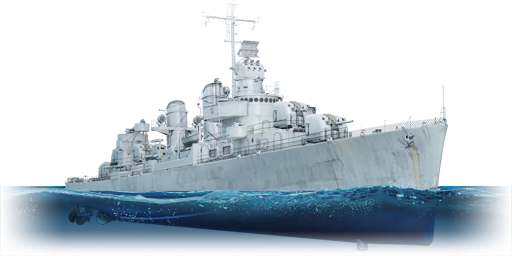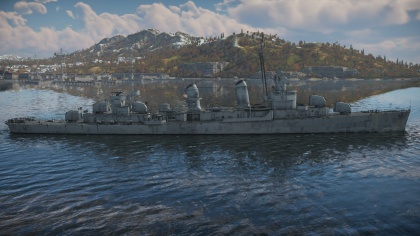USS Fletcher
Contents
Description
The Fletcher-class, USS Fletcher (DD-445), 1942 is a rank II American destroyer
with a battle rating of 4.7 (AB/RB/SB). It was introduced in Update 1.79 "Project X" as part of the fleet closed beta test.
General info
Survivability and armour
Talk about the vehicle's armour. Note the most well-defended and most vulnerable zones, e.g. the ammo magazine. Evaluate the composition of components and assemblies responsible for movement and manoeuvrability. Evaluate the survivability of the primary and secondary armament separately. Don't forget to mention the size of the crew, which plays an important role in fleet mechanics. Tips for preserving survivability should be saved for the "Use in battle" section.
If necessary, use a graphic template to show the most well-protected or most vulnerable points in the armour.
Mobility
Write about the ship’s mobility. Evaluate its power and manoeuvrability, rudder rerouting speed, stopping speed at full tilt, with its maximum forward speed and reverse speed.
Armament
Primary armament
Provide information about the characteristics of the primary armament. Evaluate their efficacy in battle based on their reload speed, ballistics and the capacity of their shells. Add a link to the main article about the weapon: {{main|Weapon name (calibre)}}.
Broadly describe the ammunition available for the primary armament, and provide recommendations on how to use it and which ammunition to choose.
Secondary armament
Some ships are fitted with weapons of various calibres. Secondary armament is defined by the weapon chosen with the control Select secondary weapon. Evaluate the secondary armament and give advice on how to use them. Describe the ammunition available for the secondary armament. Provide recommendations on how to use them and which ammunition to choose. Remember that anti-air armament, even heavy calibre weapons, belong in the next section.
If there is no secondary armament, remove this section.
Anti-aircraft armament
An important part of the ship’s armament responsible for air raid defence. Anti-aircraft armament is defined by the weapon chosen with the control Select anti-aircraft weapons. Talk about the ship’s anti-air cannons and machine guns, the number of guns and their positions, their effective range, and about their overall effectiveness – including against surface targets.
If there is no anti-aircraft artillery, remove this section.
Torpedo armament
Many ships are armed with torpedo launchers, and for some vessels such as boats, torpedoes are an extremely important means of defeating an opponent. Evaluate the position of the torpedo launchers, discuss the ammunition available, firing specifics such as dead zones, features of the torpedoes themselves, etc.
If there is no torpedo armament, remove this section.
Special armament
Depth charges, mines, rocket launchers and missiles are also effective in skilled hands and can be an unexpected surprise for an opponent. Evaluate the ammunition of this type of armament and rate its performance in combat.
Usage in battles
Describe the technique of using this ship, the characteristics of her use in a team and tips on strategy. Abstain from writing an entire guide – don’t get try to provide a single point of view, but give the reader food for thought. Talk about the most dangerous opponents for this vehicle and provide recommendations on fighting them. If necessary, note the specifics of playing with this vehicle in various modes (AB, RB, SB).
Modules
| Tier | Seakeeping | Unsinkability | Firepower | |||
|---|---|---|---|---|---|---|
| I | Dry-Docking | Tool Set | 127 mm Common Mk.32 | 40 mm HE clips | Anti-Air Armament Targeting | |
| II | Rudder Replacement | Fire Protection System | Smokescreen | 40 mm AP clips | Auxiliary Armament Targeting | |
| III | Propeller Replacement | Ventilation | Shrapnel Protection | 127 mm AAVT Mk.31 | Improved Rangefinder | Primary Armament Targeting |
| IV | Engine Maintenance | New Pumps | Ammo Wetting | Torpedo Mode | Bomb mortar | |
Pros and cons
Pros:
- Main battery has a very high ROF and quick turret traverse
- VT shells are very effective against aircraft
- Single twin 40 mm Bofors provides decent defence against aircraft
- Decent speed and manoeuvrability
- Anti-frag armour provides moderate protection from splinters and near misses
Cons:
- No armour, direct hits will cause damage, just depends on how much
- Torpedo firing arcs are less effective
History
One of the most prolific ships during World War II 175 ships of the Fletcher-class destroyer was commissioned between 1942 and 1944. The designed proved so successful that it continued to serve into the Korean and Vietnam war.[1] The Fletcher class saw widespread use across the pacific theatre and was highly successful due to its long operational range and a high degree of flexibility that made it able to tackle almost any task.[1]
Being the first generation of ship designed after the collapse of the Washington and London Naval treaties, the Fletcher was designed to be larger and carry more armament than previous destroyers. Due to the increased threat of air targets, the fletcher was also given substantial Anti-Aircraft armaments, which became very useful against the Imperial Japanese Navy. [2]
During World War 2, nineteen Fletcher class destroyers were sunk while 6 were damaged to such a degree that repair was not carried out[3]
The last Fletcher Class destroyer was decommissioned in 2001 from the Mexican Navy, which gives it an impressive service record of almost 60 years.[3]
Media
An excellent addition to the article will be video guides, as well as screenshots from the game and photos.
See also
Links to the articles on the War Thunder Wiki that you think will be useful for the reader, for example:
- reference to the series of the ship;
- links to approximate analogues of other nations and research trees.
External links
Paste links to sources and external resources, such as:
- topic on the official game forum;
- encyclopedia page on ship;
- other literature.
References
- ↑ 1.0 1.1 Friedman, Norman. US Destroyers: An Illustrated Design History (revised edition, Naval Institute Press, Annapolis, 2004), pp.111-112.
- ↑ Friedman, Norman. US Destroyers: An Illustrated Design History (revised edition, Naval Institute Press, Annapolis, 2004), pp 117-119
- ↑ 3.0 3.1 Destroyer History Foundation. (n.d.). Fletcher Class - 2,100-ton destroyers in WWII. Retrieved October 2019, from http://destroyerhistory.org/fletcherclass/.
| USA destroyers | |
|---|---|
| Clemson-class | USS Welborn C. Wood · USS Barker · USS Litchfield |
| Farragut-class | USS Aylwin |
| Bagley-class | USS Bagley |
| Porter-class | USS Porter · USS Phelps · USS Moffett |
| Somers-class | USS Somers · USS Davis |
| Fletcher-class | USS Fletcher · USS Bennion · USS Cowell |
| Allen M. Sumner-class | USS Sumner |
| Gearing-class | USS Gearing · USS Frank Knox |
| Mitscher-class | USS Mitscher · USS Wilkinson |





